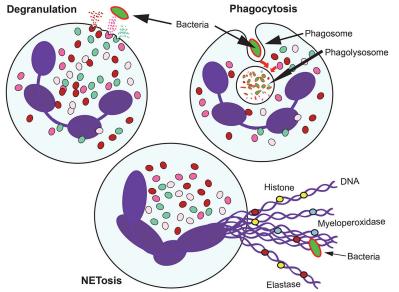All products and services are For Research Use Only and CANNOT be used in the treatment or diagnosis of disease.
Neutrophils, which constitute the predominant population of leukocytes, serve as the primary defensive mechanism of the immune system. The classification of white blood cells encompasses three distinct categories: granulocytes, lymphocytes, and monocytes. They function as a defense mechanism in safeguarding the body from potential infections and injuries, collectively. Neutrophils are generated inside the bone marrow and then circulate throughout the body through the bloodstream, as well as infiltrate various tissues and lymph nodes. Neutrophils are the first responders at the site of an immune system attack and rely on many mechanisms, such as the construction of traps and phagocytosis, to capture and eliminate invading germs or microbes. Recent research has amassed evidence indicating that neutrophils exhibit significant phenotypic variation and functional adaptability. This characteristic positions neutrophils as crucial regulators of both inflammation and immunological responses.
 Fig.1 The mechanisms of neutrophils against microbial.1
Fig.1 The mechanisms of neutrophils against microbial.1
Formation of Neutrophils
The bone marrow generates a significant amount of neutrophils, which are derived from myeloblasts. The production rate of neutrophils is regulated by the cytokines IL-23 and IL-17, which are produced outside of the bone marrow. Additionally, infective and inflammatory conditions can also accelerate the turnover of neutrophils. Promyelocyte, myelocyte, metamyelocyte, band cell, and mature neutrophil are the stages in which the maturation process moves forward. In retaining mature cells within the bone marrow, the binding of ligands to chemokine receptors CXCR2 and CXCR4 plays a crucial role. When the growth factor granulocyte-colony stimulating factor (G-CSF) is released, this retention gets over and these cells exit into the circulation. Once released into the bloodstream, neutrophils quickly die off.
Functions of Neutrophils
Neutrophils at Creative Biolabs
Presently, an expanding comprehension of neutrophil biology has illuminated and encouraged the development of novel treatment pathways. In order to cater to the demands of our global customers and streamline the transition of dendritic cell research into clinical applications, Creative Biolabs enthusiastically offers a diverse range of readily used neutrophil products that have undergone rigorous quality assurance measures. Please don't hesitate to contact us and inquire about a suitable product.
Reference
 NEWSLETTER
NEWSLETTER
The latest newsletter to introduce the latest breaking information, our site updates, field and other scientific news, important events, and insights from industry leaders
LEARN MORE NEWSLETTER NEW SOLUTION
NEW SOLUTION
CellRapeutics™ In Vivo Cell Engineering: One-stop in vivo T/B/NK cell and macrophage engineering services covering vectors construction to function verification.
LEARN MORE SOLUTION NOVEL TECHNOLOGY
NOVEL TECHNOLOGY
Silence™ CAR-T Cell: A novel platform to enhance CAR-T cell immunotherapy by combining RNAi technology to suppress genes that may impede CAR functionality.
LEARN MORE NOVEL TECHNOLOGY NEW SOLUTION
NEW SOLUTION
Canine CAR-T Therapy Development: From early target discovery, CAR design and construction, cell culture, and transfection, to in vitro and in vivo function validation.
LEARN MORE SOLUTION

